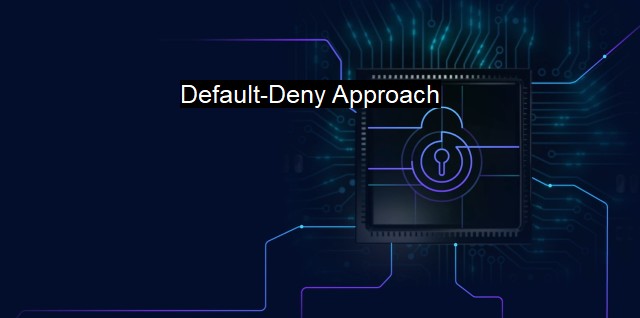What is Default-Deny Approach?
Revolutionizing Cybersecurity with the Default-Deny Approach: A Game-Changing Strategy for Combatting Sophisticated Malware Attacks
In the sphere of cybersecurity and antivirus technology, there's an approach referred to as the "Default-Deny Approach". Understood within the context of conventional security protocols amidst an escalating backdrop of sophisticated cyber threats, the Default-Deny Approach becomes deeply pertinent and instrumental.The main concept of the Default Deny Approach lies in its fundamental orientation: to deny all operations by default, unless explicitly allowed. it's a significant deviation from the security standards, where 'allow-all, block known threats' guidance is revoked in favor of a safer, albeit stricter, 'block all, permit some' paradigm. Under this policy, all actions are prevented unless they have been specifically deemed safe, marking the reversal of earlier binary classifications of hazardous and secure, which left unclassified access within the grey area.
In more traditional systems, the default behavior is 'allow'. That is, unless something was determined to be malicious, the system would allow it to go ahead. for the mistreatment to be detected, some other device should’ve had been affected by it in the past, leading to a host paradox: Catch-22 scenario. Subsequently, this exposure towards potential new exploits or 'zero-day' threats presents an inherent weakness of the 'Default-Allow' policy.
The Default-Deny Approach bridges this limitation by operating on a 'guilty until proven innocent' assumption. It combats unknown threats by blocking all operations, applications, or scripts until they are validated as secure. Therefore, by prioritizing safety over convenience, this approach poses as a potent antidote to zero-day attacks which otherwise might sneak through in a default-allow system.
There are three primary components to a comprehensive Default-Deny security ecosystem: whitelisting, sandboxing, and behavior analysis.
Whitelisting is the practice of pre-approving files, applications, or websites that a system may access. It is an integral feature of the default-deny approach as it ensures that legitimate programs required for work are not denied access. Changes to this list are usually subjected to tight controls to reduce any security breach risk.
Sandboxing, on the other hand, allows suspicious or unclassified files to run in a controlled environment isolated from the main system. The application is ‘sand-boxed’ until a decision over its authenticity is made, preventing potential malware from accessing and harming the rest of the system. This environment facilitates behavior monitoring without subjecting the governing framework to vulnerability.
Behavior analysis is the study and understanding of file or system behaviors to identify patterns indicative of malicious activity. By analyzing the behavior of whitelisted packages, administrators can gain profound insights into processes that might exhibit harmful traits. Unknown files showcasing similar patterns can be red-flagged base on their resemblance to acknowledged malicious cases.
The Default Deny Approach is not without its challenges. Too aggressive an implementation could disrupt essential operations and affect an organization's productivity. Besides this, a full transition to a default-deny setup necessitates rigorous checks at the gateway stage to comprehensively verify or discredit software dependencies.
The Default-Deny Approach, despite its strengths and weaknesses, offers a foundational shift from yesteryears of cybersecurity. It indicates a move from a more passive response to threats to an active strategy preempting their occurrence, effectively defying the signature falsehood "secure until proven otherwise". The drastic change implies a necessity to adapt or contest the rising wave of unknown threats, enforcing stringent security measures at the expense of perceived inconvenience.

Default-Deny Approach FAQs
What is a default-deny approach in cybersecurity and antivirus?
A default-deny approach is a security model that denies all access to a system or network by default, except for explicitly allowed and pre-approved traffic. This approach is used to protect against potential security threats and reduce the attack surface of a system or network.How does a default-deny approach work?
A default-deny approach blocks all incoming and outgoing traffic by default, including network protocols, ports, and services. Access to specific resources or applications is only granted when it is explicitly allowed and pre-approved by the security policy. Any attempt to access a denied resource or application is immediately rejected, and an alert may be generated to notify security personnel of a potential threat.What are the advantages of a default-deny approach?
A default-deny approach provides a high degree of security by minimizing the attack surface of a system or network. It reduces the risk of unauthorized access, malware infections, and data breaches. It also simplifies the security policy by only allowing approved traffic, making it easier to monitor and manage security events.Are there any disadvantages to a default-deny approach?
One potential disadvantage of a default-deny approach is that it can be time-consuming to configure and maintain, especially in large and complex environments. It may also result in false positives or blocked legitimate traffic if the security policy is not properly configured or updated. Additionally, it may not be suitable for organizations that require more open access to their network resources, such as those that rely heavily on BYOD policies or remote work.| | A | | | B | | | C | | | D | | | E | | | F | | | G | | | H | | | I | | | J | | | K | | | L | | | M | |
| | N | | | O | | | P | | | Q | | | R | | | S | | | T | | | U | | | V | | | W | | | X | | | Y | | | Z | |
| | 1 | | | 2 | | | 3 | | | 4 | | | 7 | | | 8 | | |||||||